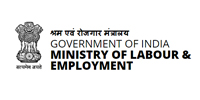Apprenticeship Training Scheme
- APPRENTICESHIP TRAINING SCHEME
- To regulate the programme of training of apprentices in the industry so as to conform to the prescribed syllabi, period of training etc.as laid down by the Central Apprenticeship Council; and
- To utilise the facilities available in industry for imparting practical training with a view to meeting the requirements of skilled manpower for industry
- Directorate General of Training under Ministry of Skill Development and Entrepreneurship monitors the implementation of the Apprentices Act in respect of Trade Apprentices in the Central Government Undertakings & Departments and establishments operating business 4 or more states through six Regional Directorates of Apprenticeship Training (RDAT) located at Chennai, Faridabad, Hyderabad, Kanpur, Kolkata, & Mumbai.
- State Apprenticeship Advisers are responsible for implementation of the Act in respect of Trade Apprentices in State Government Undertakings/ Departments and Private Establishments.
- Department of Education in the Ministry of Human Resource Development is responsible for monitoring the implementation of the Act in respect of Graduate, Technician & Technician (Vocational) Apprentices. This monitoring is done through four Boards of Apprenticeship Training located at Chennai, Kanpur, Kolkata and Mumbai.
- DGT, New Delhi is the apex statutory body.It is tripartite by constitution with members from Government both Central and States/UTs, Employers etc.
- It advises the Government on laying down of policies and prescribing norms & standards in respect of Apprenticeship Training.
- Designated trade means any trade or occupation as notified by the Government.
- Optional trade means any trade or occupation decided by an employer.
- It is obligatory on the part of employers having manpower strength 30 or more and having requisite training infrastructure as laid down in the Act, to engage apprentices.
- Employer shall engage of apprentices in a band of 2.5% to 10% of total manpower strength of the establishments including contractual staff.
- The establishments /Employers can decide the categories of apprentices and trade(s) in which the apprentices to be engaged depending upon the facility available with them for imparting On-the- Job Training/ practical training at his workplace.
- The minimum rate of stipend per month payable to trade apprentices is as follows:
- Sharing of 25% of prescribed stipend subject to a maximum of ₹1,500/- per month per apprentice with the employers. The stipend support would not be given during the basic training period for fresher apprentices.
- Sharing of basic training cost in respect of apprentices who come directly to apprenticeship training without any formal trade training. Basic training cost will be limited to ₹7,500/- for a maximum of 500 hours/3 months.The expenditure on stipend for trade apprentices is borne by the employers.
- Minimum age is 14 years.
- Qualifications vary from Class VIII pass to XII class pass (10+2) system.
- Period of training varies from one year to4 years
- Training comprises Basic Training and Practical Training.
- 261 trades in 39 trade groups have been designated.
- Numbers of seats for apprentices are calculated in the band of 2.5% to 10% of the total strength of the workers.
- Every apprentice and employer has to enter into a contract of apprenticeship training, which is registered by the Apprenticeship Advisers.
- Employers and apprentices have to fulfil their obligations under the Act.
- All India Trade Tests (AITT) for trade apprentices are conducted by National Council of Vocational Training (NCVT) twice a year (October/ November and April/May).
- National Apprenticeship Certificates (NAC) are awarded to those who pass the AITT.
- NAC is recognized for employment under Government/Semi-Government departments/ organizations.
- ACTIVITIES:
- The list of industries covered under the Factories Act, Puducherry is utilized for the survey for the feasibility of locating a training location in that establishment. Beyond the factories covered under the Factories Act, the establishment list where the feasibility to locate a training place under the Apprenticeship Act in the informal sector training also used for survey
- Training places are being located as per the provisions of Apprentices Act, 1961 and rules made thereunder adhering to the RATIO prescribed by DGT, New Delhi between Total Employees : Apprentice.
- Under Apprentice Act, 1961 there are 133 designated trades, as on date by the DGT, New Delhi.
- 1130 training places were located in 20 trades in respect of UT of Puducherry.
- A person who has to undergo Apprenticeship Training should possess a minimum educational qualification prescribed for each trade which varies from VIII standard to Degree / Diploma holders in Engineering / Technical Trades.
- Online portal would be used for administering the implementation of the Apprenticeship Training. It will address the requirements of all key stakeholders.
- The link of the Online Apprenticeship Portal is https://apprenticeshipindia.org
- Portal will facilitate: Candidate Registration
- Portal will also facilitate for time bound approval of contract of apprenticeship, centralized database for compliance and monitoring, online verification of candidates profile, management of on-line examination for generation and issue of hall tickets.
- On-line registration indicating their sector/trades of choice
- Sending application to potential employers for apprenticeship training
- Online receipt and acceptance of offer letters from establishments
- Process all necessary contractual obligations online.
- Search and select Basic Training Provider (BTP) specific to sector, trades and region
- On-line registration
- Declare apprenticeship seats/vacancies
- Search & shortlist candidates specific to sector, trades, region etc.
- Issue offer letters to candidates for engaging as apprentices
- Monitoring of apprenticeship training.
- On-line submission of returns and records
- On-line submission of claims.
- Online payment of Government share
- As per the Apprentices Act, monitoring of apprenticeship training in State Public Sector Undertakings and Private Sector Establishments is done by the respective State Governments.
- Generally, it has been seen that State Governments do not play an active role in promoting apprenticeship training so it has been decided to involve the states in implementing the new scheme. State Apprenticeship Council will be entrusted to setup an Apprenticeship Cell in each State and their responsibilities will include monitoring the implementation of this scheme.
- Facilitators/Promoters in the system are essential for mobilizing the apprentices. Since this scheme involves multiple stakeholders, the role of facilitators becomes important.
- Facilitators can also create awareness among the employers which is generally lacking in our country.
- The facilitators can also play a major role in coordinating between basic training providers and the employers for on-the-job training.
- Workshop/Seminars Meetings/Workshops will be organized with all stakeholders including CII, FICCI, ASSOCHAM, Sectoral Associations and local industry chambers/clusters.
- Publicity & advertisements using both print and electronic media.
- Brand Ambassadors Appointing Brand Ambassadors for states and for local industrial clusters to act as facilitators and promoters to promote apprenticeship training. Brand Ambassadors may be from large, medium and small industries. These will be actual practitioners & will include those employers who have/are engaging apprentices. Brand ambassadors will be formally recognized by granting them certificates/badges.
- IMPLEMENTATION PLAN:
- Reservation for SC/ST, Physically Handicapped, Women etc., along with that the Backward classes as announced by the DGET recently. In every designated Trade prescribed percentage of Training places are reserved for Candidates belonging to SC/ST, PH, BC and Women etc.
- Provision for Reservation of Training places for SC/ST: In every designated trade, training places shall be reserved by the employer for the SC/ST (and where there is more than one designated trade in an Establishment, such training places shall be reserved also on the basis of the total number of apprentices in all the designated trades in such establishment.)The number of training places to be reserved for the Scheduled Castes and the Schedules Tribes under Sub-Section (1) shall as such as may be prescribed having regard to the population of the SC and ST in the State Concerned
- Reservation of Training places for Physically Handicapped: Government of India has requested State Directorates to ensure that at least 3% of located seats for Apprenticeship Training are utilized by the Physically Handicapped person
- Reservation of Training places for Backward Classes: Government of India has requested State Directorate to ensure the reservation to the trainees belonging to the Backward Classes among the located seats for Apprenticeship Training
- Employer is any person/entity who has business in any trade or occupation.
- The employers interested to avail the benefits of the scheme must fulfil the following: Employer shall engage apprentices in a band of 2.5% to 10% of the total strength of the establishment
- An apprentice is a person who has made contract of apprenticeship with the employer for apprenticeship training under the Act.
- Apprentices can be engaged from the following categories:
- Apprentice must fulfill the following:
- Number of apprentices mentioned at 8.2(v) above may be upto 20% of the target in a year.
- Government & Private Industrial Training Institutes.
- Industries/ establishments with in-house basic training facilities.
- BTP set up/supported by Industry clusters
- Government/Private ITI will automatically get selected as a BTP provided that they have spare seats (within overall affiliation) for running basic training. Spare shifts may be used for basic training.
- BTP will have to apply through portal for registration
- RDAT will review the application of BTP
- RDAT will arrange for physical inspection of BTP by a committee constituted for this purpose.
- Submission of Inspection report on-line by the committee.
- Review of inspection report and approval of BTP by RDAT
- Selection and offer to BTP on-line by RDAT.
- After approval, they can get registered
- After approval, they can get registered.
- BTP must have an Aadhaar linked Bank Account
- Designated trade
- Designated trade means any trade or occupation as notified by the Government. At present, there are 259 designated trades available for apprenticeship training. List is available on apprenticeship portalhttps://apprenticeshipindia.org.
- Optional trade
- Optional trade means any trade or occupation or any subject field in engineering or non-engineering or technology or any vocational course as may be determined by the employer.
- Employer may shortlist candidates’ specific to sector, trades, region etc. and offer letters to candidates for engaging through portal. Employer may also select apprentices off-line and upload the details of apprentices before start of apprenticeship training on the portal. Contract of apprenticeship must be entered between apprentice and the employer. The contract of apprenticeship must be registered with concerned Apprenticeship Adviser through the portal.
- The Employer shall make suitable arrangements for imparting a course of practical Training to every Apprentice engaged by him in accordance with the programme approved by the State Apprenticeship Advisor.
- The basic training is to be imparted by the employer himself if he employs 500 or more workers in his establishment.
- The Employer shall pay stipend to the apprentices at the rate specified from time to time by the 10th of the following month.
- When the contract of apprenticeship is terminated on account of failure on the part of Employer he shall pay compensation to the Apprentice of to his guardian as per rules.
- Also if personal injury is caused to an apprentice by accident arising out of and in the course of training the Employer shall be liable to pay compensation as per the provision of Workmen's Compensation Act, 1923.
- If any employer contravenes the provision of Apprentice Act relating to the number of Apprentices which he is required to engaged he shall be punishable with imprisonment for a term which may be extended to six months or with fine or both (Section 30 (a) of the Apprenticeship Act, 1961).
- RDATs/States will make the payment towards cost of basic training to Basic Training Providers through their bank account. Rs. 5000/- per apprentice as a basic training cost shall be made after successful completion of basic training and the remaining basic training cost i.e. Rs. 2500/- per apprentice shall be paid after completion of apprenticeship training by the apprentice.
- ALL INDIA TRADE TEST
- Each and every apprenticeship has completed the period of apprenticeship training shall appear in the All India Trade Test conducted biannually as per exam schedule communicated by the DGE&T, New Delhi, during April / May and October / November every year.
- So for 110 All India Trade Tests have been conducted. Exam fees of Rs.50/- is being collected from the apprentices appearing for the first time and Rs.75/- for the subsequent attempt.
- An apprentice can avail five additional chances to appear in the AITT within a period of 3 years to pass the Final Trade Test after appearing the first exam as per the DGE&T Letter No. DGET 49(1)/82-AP dated 22nd August 1983.
- As per the new examination patter announced by the DGE&T vide Order No.DGE&T-23(7)(2007)/2007-AP dated 15/10/2007 the NTC holder apprentices engaged on and after 01/04/2007 were need to appear only two subject namely Trade Practical and Trade Theory.
- Trade Practical Examination will be conducted by the concerned establishment at their premises.
- Trade Theory examination will be conducted through online mode.
- All successful Apprentices of the All India Trade Test are awarded with National Apprenticeship Certificate under the signature of the State Apprenticeship Advisor.
- National Apprenticeship Certificate to the successfully completed Apprentices can be downloaded from the NAPS Portal.
- TRAINING PLACES IN THE UNION TERRITORY OF PUDUCHERRY
- Public Sector :91
- Private Sector : 169
- Total :260
- LIST OF DESIGNATED TRADES WHERE SEATS HAVE BEEN IDENTIFIED
BACKGROUND
Development of human resource is crucial for the industrial development of any nation. Up-gradation of skills is an important component of Human Resource Development. Training imparted in institutions alone is not sufficient for acquisition of skills and needs to be supplemented by training at the workplace. The Apprentices Act, 1961 was enacted with the prime objective to utilize fully the facilities available in industry for imparting practical training with a view to meeting the requirements of skilled manpower for industry. Initially, the Act covered the apprenticeship training for the trade Apprentices and subsequently amended in 1973, 1986 and 2014 to bring the Graduates, Technician, Technician (Vocational) and Optional Trade Apprentices respectively under its purview.
The scheme was enacted in the Union Territory of Puducherry since from 1969. The Apprenticeship Training Scheme was introduced during the year 1968-69 under the Administrative control of Inspector of Factories with the only post of Surveyor Cum Technical Assistant. Subsequently, the Assistant Director (Training), Puducherry was declared as Deputy Apprenticeship Advisor and started implementing the Apprenticeship Training Scheme under the overall control of the Commissioner of Labour cum State Apprenticeship Advisor. The scheme was initially incepted at Public establishment at Puducherry and then expanded to the private establishment covered under the Factories Act. Apart from training Craftsman Training Scheme trained trainees to the industrial orientation and safety conditions to the need of the industrial manpower, the apprenticeship training scheme identified some job oriented skills other than engineering sector called informal sector. Job oriented courses like Gardener, Lab Attender, etc., were included to cover under the Apprenticeship Training.
The innovative experience of this Act, is the frequent / regular introduction of training sectors to meet the raising manpower need in the country. It is effectively brought to the notice of the Central Apprenticeship Council which makes decisions based on the recommendations of the State Apprenticeship Council.
In respect of ITI trained trainees, State Apprenticeship Advisor is the authority and for the Diploma and Degree Engineers, State Board of Apprenticeship Training, Taramani, Chennai is the authority.
Objectives
Apprentices Act, 1961 was enacted with the following objectives:--
Monitoring of the implementation of Apprenticeship Act:
Central Apprenticeship Council:
Fields of Apprenticeship Training:
Apprenticeship training can be provided to apprentices both in designated and optional trades.
Coverage:
Stipend :
| YEAR | MINIMUM RATE OF STIPEND |
|---|---|
| First Year | 70% of minimum wage of semi-skilled workers notified by the respective State or Union territory. |
| Second Year | 80% of minimum wage of semi-skilled workers notified by the respective State or Union territory. |
| Third & Fourth Year | 90% of minimum wage of semi-skilled workers notified by the respective State or Union territory. |
Training of Trade Apprentices:
Testing and Certification of Trade Apprentices:
Identification of Industrial Units:
Designated Trades:
Educational Qualification for Apprenticeship Training:
Ease of Administering through Technology:
Establishment Registration
Regional Directorate of Apprenticeship Training/State Apprenticeship Advisor Activities
Basic Training Provider
Candidate Registration in the NAPS Portal:
Establishment Registration in the NAPS Portal:
Involvement of States/UTs:
Promoters and facilitators for Apprenticeship Training:
Communication campaign:
Reservation of Training Locations in Apprenticeship Training:
Eligibility of Employer:
Employers must have EPFO/ESIC/Factory/ Cooperative/ MSME registration number
Employers must have TIN/TAN number
Employers must register on the apprenticeship portal.
Employers must have an Aadhaar linked bank account
Eligibility of Apprentice:
a) Trainees passed out from ITI courses
b) Trainees under dual-learning mode from ITIs
c) Trainees who have completed PMKVY/MES -SDI courses or courses approved by State Governments/Central Government.
d) Graduates/diploma holders or pursuing graduation/ diploma in any stream or 10+2 vocational certificate holders (Apprentices who are not covered under NATS administered by MHRD)
e) Candidates who possess minimum educational qualification required for a trade and have not undergone any formal trade training (Fresher apprentices)
He/she has completed 14 years of age and fulfills other requirements of the Apprentices Act, 1961.
Every apprentice has to register on the portal.
Every apprentice must have an Aadhaar number.
Must possess minimum age, educational and physical qualification prescribed for the trade
Eligibility of Basic Training Providers:
(i) Basic Training Provider (BTP) is an entity who has the facilities for imparting basic training to apprentices.(ii) Types of BTPs:
Fields of apprenticeship training:
Apprenticeship training can be provided to apprentices both in designated and optional trades.For the purpose of this scheme, the optional trades are categorized as under :
a) PMKVY/MES–SDI or Courses approved by State Governments/Central Government - All courses under PMKVY, MES-SDI or courses approved by State Governments/Central Government with a duration of 20-25% of the total duration of apprenticeship training as basic training component. Remaining duration will be for practical content for on-the-job training as designed by respective course approving authority. These courses will be declared as optional trades & will be notified on apprenticeship portal
b) Created by employer –Trades decided by employer with a duration of 20-25% of total duration of apprenticeship training as basic training component. Remaining duration will be for practical content for on practical content for on—the - job component as designed by employer and uploaded on the apprenticeship.
Duration of Apprenticeship Training
Apprenticeship Training consists of Basic Training and On-the-Job-Training/Practical Training at the workplace in the industry. Duration of apprenticeship training for different routes for getting the financial benefits of the scheme will be as follows:| ROUTES OF APPRENTICESHIP TRAINING | DURATION OF BASIC TRAINING | DURATION OF PRACTICAL TRAINING/ON-THE-JOB TRAINING | |
|---|---|---|---|
| MAXIMUM | MAXIMUM | MINIMUM | |
| ITIs pass-outs | Not Required | 1 Year | 2 Years |
| Trainees who have completed PMKVY/ MES-SDI courses or courses approved by State Governments/ Central Government | -do- | 1 Year | 2 Years |
| Graduates/ diploma holders or persons pursuing graduation/ diploma in any engineering stream or medical or paramedical (Apprentices who are not covered under NATS administered by MHRD) | -do- | 1 Year | 2 Years |
| Graduates/ diploma holders / 10+2 vocational certificate holders or persons pursuing graduation/ diploma in Arts or Commerce or Science streams such as B.A., B.Sc., B.Com., L.L.B etc. | -do- | 1 Year | |
| Dual-learning mode from ITIs | -do- | 5 to 9 months | |
| Fresher apprentices | -3 months- | 1 Year | 2 Years |
Contract of Apprenticeship
Responsibility of Employer:
Processing of Claims:
Payment of reimbursement claims towards stipend to the Employers
(i) Payment of full rate of prescribed stipend, including Government of India’s share shall be paid to apprentices by the establishment through the Aadhaar linked bank accounts of apprentices. For this purpose, the employers are required to seek bank details from the apprentices.(ii) Establishments are required to upload a proof for payment of full amount of stipend to the apprentice alongwith the attendance particulars. Government of India’s share will be reimbursed on a quarterly basis by the respective RDAT or SAA.
(iii) Concerned RDATs/States will verify the information uploaded by the establishment and on confirmation of the training conducted and full amount of stipend paid, they will reimburse the payment to establishments’ bank account within 10 days from the receipt of claims from the employers.
Sharing of Basic Training Cost to Basic training Providers
The following procedure shall be adopted under the scheme for payment of basic training cost i.e. ₹7,500/- per apprentice for 500 hours/3 months:
Monitoring of the establishments:
Monitoring is required to ascertain the status of implementation of the scheme. Therefore, it is expected that 5% to 10% of the total beneficiary establishments under the scheme would be subject to actual physical verification every year.
Certificate after the Completion of Training:
| SL.NO. | TRADE | TRAINING PLACES LOCATED | ||||
|---|---|---|---|---|---|---|
| Pondicherry | Karaikal | Mahe | Yanam | Total | ||
| 1. | FITTER | 220 | 48 | 2 | 5 | 275 |
| 2. | Electrician | 188 | 21 | 2 | 13 | 224 |
| 3. | Wireman | 75 | 8 | 2 | 3 | 88 |
| 4. | Mech. Motor Vehicle | 66 | 6 | - | 1 | 40 |
| 5. | Mechanic Diesel | 20 | 3 | - | - | 23 |
| 6. | Carpenter | 4 | - | - | - | 4 |
| 7. | Mechanic R & A/c | 18 | 2 | 1 | - | 21 |
| 8. | Welder | 26 | 5 | - | - | 31 |
| 9. | Electronic Mechanic | 78 | 1 | - | - | 79 |
| 10. | Instrument Mechanic | 7 | 15 | - | - | 22 |
| 11. | Draughtsman Civil | 10 | 4 | 3 | 1 | 18 |
| 12. | Mason | 20 | 13 | - | 3 | 36 |
| 13. | Turner | 19 | 1 | - | - | 20 |
| 14. | Machinist | 15 | - | - | - | 15 |
| 15. | P.P.O. | 19 | - | - | 1 | 20 |
| 16. | PASAA | 220 | 48 | 2 | 5 | 275 |
| 17. | Boiler Attendant | 16 | - | - | - | 16 |
| 18. | Offset machine Minder | 7 | - | - | - | 7 |
| 19. | Gardener | 40 | - | - | - | 40 |
| 20. | Tailors (General) | 30 | - | - | - | 30 |
| TOTAL | 934 | 155 | 12 | 29 | 1130 | |
NUMBER OF ESTABLISHMENTS COVERED
In UT of Puducherry, out of 261 designated trades, seats have been identified in the following 20 trades for the Apprenticeship Training.
| SL.NO. | DESIGNATED TRADES |
|---|---|
| 1. | FITTER |
| 2. | Electrician |
| 3. | Wireman |
| 4. | Mason(B.C.) |
| 5. | Draughtsman - Civil |
| 6. | Carpenter |
| 7. | Mechanic Motor Vehicle |
| 8. | Mechanic Diesel |
| 9. | Boiler Attendant |
| 10. | Machinist |
| 11. | Turner |
| 12. | Electronic Mechanic |
| 13. | Instrument Mechanic |
| 14. | Mechanic (Refrigeration and Air-Conditioner) |
| 15. | Off-Set Machine Minder |
| 16. | Plastic Processing Operator |
| 17. | Welder (G & E) |
| 18. | PASAA |
| 19. | Gardener (Informal Sector) |
| 20. | Tailor (General) |













